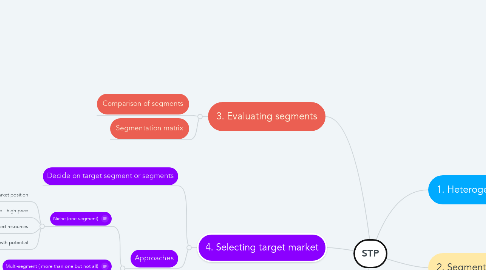STP
by Shezwin Bangsajayah


1. 3. Evaluating segments
1.1. Comparison of segments
1.2. Segmentation matrix
2. 4. Selecting target market
2.1. Decide on target segment or segments
2.2. Approaches
2.2.1. Niche (one segment)
2.2.1.1. Strong market position
2.2.1.2. Low sales volume - high price
2.2.1.3. Focused limited resources
2.2.1.4. Risky with limited growth potential
2.2.2. Multi-segment ( more than one but not all)
2.2.2.1. Different products for different segments.
2.2.2.2. Lots of costs
2.2.3. Mass
2.2.3.1. Multi-segment ( more than one but not all)
2.2.3.2. High volume, less price. but big gain.
2.2.3.3. High economic sales
3. 5. Positioning
3.1. Key attributes that distinguish from other brands
3.2. Relative to leader
3.3. Examples
3.3.1. Distinct atributes
3.3.2. Value for money
3.3.3. Innovation
3.3.4. Against the trend
3.3.5. Repositioning
4. 1. Heterogeneity of market
4.1. Heterogeneous
4.2. Homogeneous
5. 2. Segmenting
5.1. Demographic
5.1.1. Age/ gender/ income/ occupation/ wealth/ family size
5.2. Lifestyle (psychographic)
5.2.1. Status seekers/ trendsetters
5.3. Geographic
5.3.1. Suburb/ city/ state/ country
5.3.2. Population/ climate
5.4. Behavioural
5.4.1. Benefits sought
5.4.2. Usage rate/ loyalty
